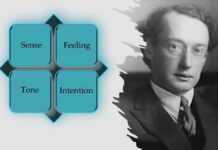Language is a system of communication. A system comprises a set of signs or symbols arranged in a particular pattern and has some meaning. Speech and writing are the two modes of linguistic communication. Language is the fundamental medium on which human culture rests. Language is a part of human behaviour and is an integral part of the human mind.
The human child learns to speak between the age of 1 and 3. A child first acquires the ability to speak his mother tongue. This is supposed to be a critical period of language learning. The genetic capacity for language acquisition has been triggered in contact with others speaking around the child. He learns to write it only at a later stage. The first language of a child is its mother tongue too. However, it need not always be so. A child born outside the native place of its parents may be brought back after a few years.
The first language which the child started speaking abroad may be replaced gradually by the language of the place it has settled in. The mother tongue is the expression of the culture with which the child identifies itself with. The mother tongue has great deep emotional roots in the child. Sometimes a foreign language may become the predominant language of a person by its constant use in his professional sphere. The first language one has learned in childhood may be forgotten by long disuse.
A second language is learned second in the order of time. It is different from a core language that is learned along with L1 in a bilingual or trilingual situation. Children learn two or three languages simultaneously if they are in such an environment. One’s first language is acquired spontaneously as a part of the maturational process whereas a second language is learned in an institutional environment. A second language may be acquired through prolonged contact with people who use it.
According to Stephen Krashen, Acquisition requires meaningful interaction in the target language or natural communication in which speakers are concerned not with the form of their utterances, but with the message, which is “conveying and understanding”. The acquisition is a product of a subconscious process similar to children’s acquisition of L1. Meaningful interaction of children is in the communicative act, not in the form of their utterance.
Language acquisition is influenced by both subjective and objective factors in several ways. Some of the learner factors are Need, Aim, Practice, Age, Temperament, Previous knowledge, Imitation, Gender, Intelligence, Aptitude, Interest, Motivation, Readiness, Personality, Physical condition, Emotional development, etc.
A second language situation is that where the language is learned is not the mother tongue of any group within the country, but it does have some internal function in government administration, education, politics, law, medicine, industry, newspaper, etc. A foreign language situation is one in which the target language is not the mother tongue of any group within the country where it is learned and has no internal communication function. The aim of learning a foreign language is to use it abroad, to be able to communicate with foreigners or to be acquainted with the culture and literature of the language.
A second language is a language necessary for certain official, social, commercial or educational activity within their country. India maintains English as a medium of instruction for approximately half its total higher education. A child acquires its first language under the affectionate support of the elders and in constant exposure. A second language is learned after L1 habits have stabilized. There is only limited exposure to the second language in classroom conditions. The atmosphere is more formal. Then informal or warm The exposure is graded step-by-step and under a total plan. A lot of practice exercises are also done. In learning a second language, the learner makes his interlanguage or hypothetical stages.
According to Selinker learning a new language is an integrated interlingual experience as it involves an interaction between the learner’s knowledge of his first language (native language) and of the new language (target language). The result of this attempted production of a Target Language norm is interlanguage (IL). This should be studied in its different phases of development and are called interlanguage studies or the studies of learner language. Thus language has a three-fold status: first language, second language and foreign language.
Language teaching includes all activities intended to bring about language learning, classroom instruction, preparation of teaching materials, training of teachers, curriculum planning, teaching aids, teaching grammar dictionaries and other administrative provisions are connected with teaching. A good theory of language teaching answers the needs and conditions of the language learner. The word teaching often stands for learning and these activities are not separated.
Learning takes place in the mind of the student as a result of the rapport or feedback between the teacher and the student. The impact of social, cultural and personal factors will influence the learning progress of the student positively or negatively. The features and attitudes of the teacher have a great influence on the students.
The teaching-learning process of English, our second language, is a complex one compared to the acquisition of the first language. Sustained effort and suitable methodology will solve this complexity and make the challenge a matter of intense pleasure, which becomes highly rewarding.






























